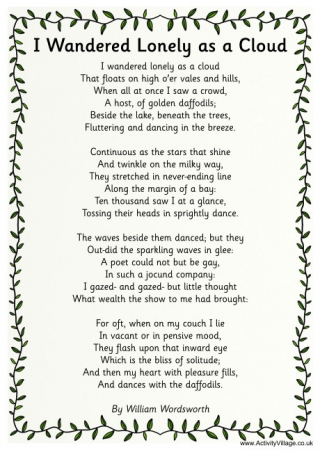
In the fourth and last stanza of the poem the speaker describes his state of mind from another point of view. The speaker abandons the initial aimless, wandering for the sight of daffodils. The flowers alone are in the focus of his attention. The speaker is transfixed upon them, not thinking about what riches this sight might bring him. The act of gazing at the daffodils is very long and constant. His astonishment from the sight before him is obvious: “I gazed–and gazed–but little thought / What wealth the show to me has brought”(l.17-18). While in the beginning he clouded his true identity and expressed his lack of companionship when “wandering” about with his thought, now he declares himself of being a “poet”, who enjoys the “company” of the daffodils. This is a turning point in the speaker’s status as presented in the beginning of the poem. The speaker feels he belongs to something, he states his purpose or destination as a poet– the maker of the literary piece, which commemorates the magnificence of the daffodils: “A poet could not but be gay / In such a jocund company”(l. In the third stanza the speaker expresses his emotions openly and directly as he leaves the lonely cloud for the company of the cheerful company of the daffodils, which were able to surpass even the waves by their happy dancing (l.13-14). The speaker uses another personification, which expresses the vividness and vitality of the flowers as part of nature and as a group, which operates together. The speaker is impressed by the number of the flowers and their movements in the wind, “tossing their heads in sprightly dance”(l.12). The speaker repeats the description of his encounter with the daffodils like he did in the first stanza, when trying to do something almost impossible as catching ten thousand daffodils with a single “glance”(l.11). They are uncountable, like the stars in heaven. The speaker attributes the daffodils an aspect of endlessness, infinite quality they have, which has no limits: he describes them as “continuous”(l.7), “stretched in never-ending line”(l.9). The speaker elevates and positions them above himself, as the stars on the Milky Way, and thus brings them closer to him. Now, the earthly daffodils are identified with something of the speaker’s own metaphorical world (celestial universe). In the second stanza the speaker uses another simile to compare the golden daffodils with the shine of stars. The wind bridges the worlds of the speaker as a cloud in the sky and the daffodils, which move in the light breeze. The atmosphere in this scene is very calm, peaceful and harmonious. The speaker personifies the daffodils and describes their movement in the wind as an act of “fluttering” and “dancing”. There is a contradiction between the position of the speaker and the daffodils: he is all by himself while they outnumber him, he is above and they are down below (beneath the trees). To emphasize the numerous flowers he uses two words one after another, “crowd” and “a host”.


This state changes when he surprisingly notices many daffodils by the lake: “All at once I saw a crowd / A host, of golden daffodils ”(l.3-4). It might suggest that he does not feel connected to the human physical, earthly world and so chooses to be identified with a cloud, which floats above, uninvolved in what happens down below, a passive spectator.


However, despite the freedom and the absence of some kinds of attachments or obligations, the speaker finds himself lonely and secluded. Just like the cloud, earthly rules or occurrences do not bound him. The speaker has no intention or purpose in his actions he lets the muse, or the wind, carry him off to where it might lead him. The poem begins with a simile, which the speaker uses to describe his process of wondering or thinking as the aimless, free, metaphysical wandering of a cloud in its celestial route above earth: “I wandered lonely as a cloud”(l.1). In this essay I will discuss the connection between the natural scene and the speaker’s state of mind by analyzing the imagery and figurative language of the poem. These changes are physical, psychological and emotional. The poem is written in a figurative language, combining images, similes and words that denote mood, atmosphere and colors to reflect the changes in the speaker’s position. The description of the process, which the speaker goes through, is represented by a natural scene where the speaker, plants and the surroundings become united. William Wordsworth’s “I Wandered Lonely as a Cloud” is a lyric poem, which deals with the speaker’s state of mind.


 0 kommentar(er)
0 kommentar(er)
